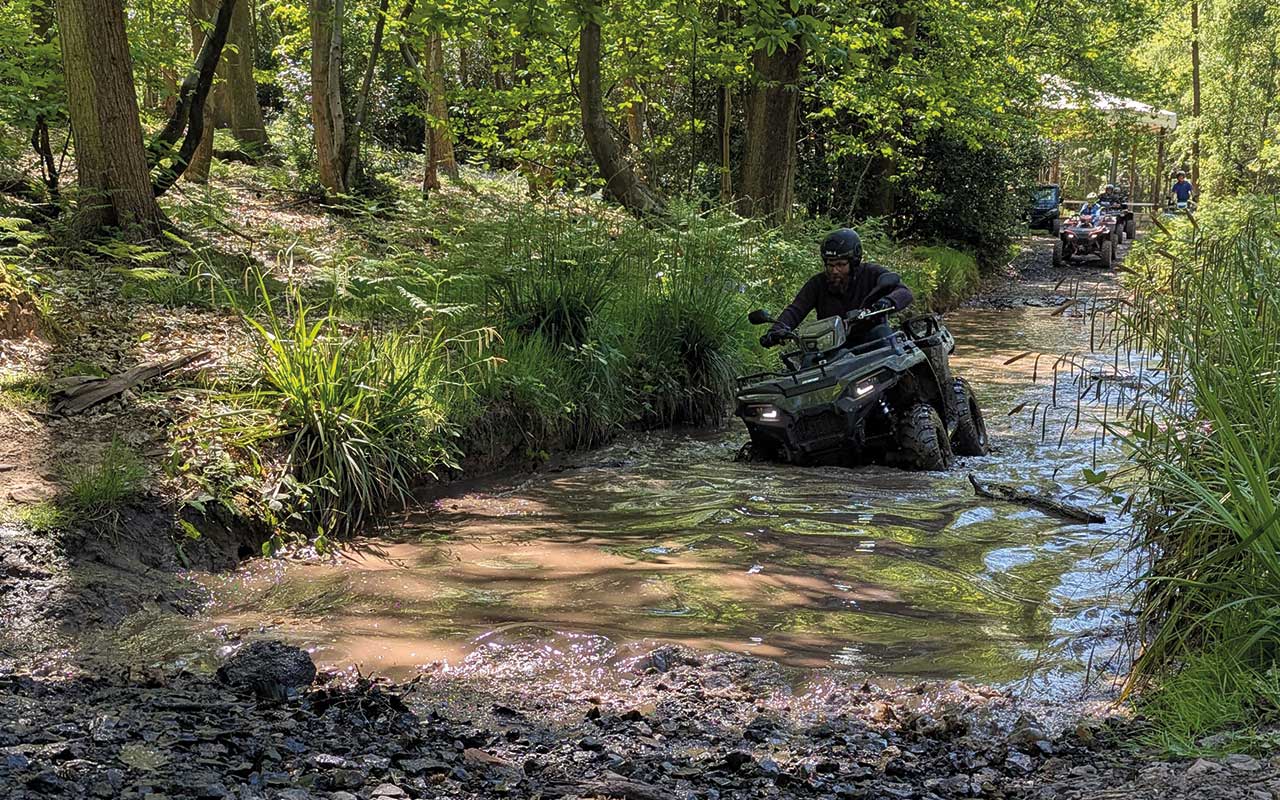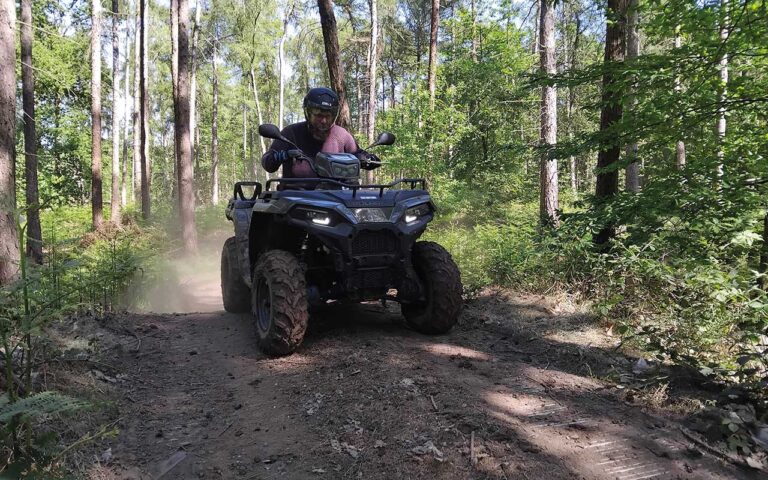At the back of the Heart of England Showground, there was a line-up of Polaris quads and UTVs, and three tracks for us to put them through their paces.
The line-up included a series of Sportsman 570 EPS units, the 570cc unit which the company claims is the most popular for farmers; the special edition Nordic Pro version, which adds a host of features, both practical and for comfort; and the 1,000cc model.
While the 1,000cc version is certainly fun, with a lot of power tucked into the compact frame, we focused on the standard Sportsman, and for day-to-day use it’s hard to imagine needing much else.
The courses we went through included grassland, some steep slopes and lots of mud, and the base 570 was more than capable of handling it all.
It is powered by a ProStar single-cylinder engine, with electronic fuel injection and an automatic transmission, with high and low ranges.
Even when in gear, the machine doesn’t move without touching the throttle, although obviously it’s safer to drop it into park when not moving.
From previous experience, we found Polaris machines have a millisecond delay between touching the throttle and the machine moving forward.
This is still there, but it has some serious acceleration potential when it kicks in. We could easily accelerate to the top speed in a matter of seconds when we had a straight run ahead of us.
Unlike some other machines on the market, this rapid speeding-up wasn’t accompanied by a jolt to the drive; instead, we felt rooted in the seat as the machine took off.
Ride comfort
The machine was comfortable to drive on the dirt tracks and grassland. The front and rear suspension work well together to keep all four wheels planted, dampening bumps along the route. This also made it feel safe – as we accelerated and cornered, the machine was responsive.
Electronic power steering helped here, adapting to the speed we were travelling at and the tightness of the turn to adjust the resistance as required.
If you’re not planning on taking the machine into difficult conditions, it’s also an intuitive vehicle to drive. You’ve got the throttle, front and rear hydraulic brakes, and the gear lever down by the right leg.
This was the clunkiest part of the machine, occasionally taking a bit of brute force to move between park, reverse, low and high. It was function over form.
While we didn’t get to test this, it’s worth noting that the towing capacity is rated to 680kg and the machine can be specified with a rack capacity.
While nowhere near matching the capabilities of a UTV – and there is some argument about why you would choose an ATV over a UTV in most conditions – it does make this a practical machine as well as something fun to drive.

Muddy boots
The second part of the track included rougher terrain with some muddy spots, which got progressively worse throughout the day.
Here we weren’t testing the speed of the machine, but how it would handle something close to real-life conditions.
On the drier inclines, we never touched the gearing, keeping it in two-wheel drive and high, and just feathering the throttle on the decline.
When we hit the muddy spots, we dropped the 570 into low and used the thumb switch to activate the all-wheel drive.
In low, the 570 limits its top speed, keeping the engine speed where the torque is at its peak, to try to keep the wheels turning even in the worst conditions. Even on later runs, with deep ruts and churned-up mud, the Sportsman performed well. We didn’t hit any areas where we felt we couldn’t keep moving.
This is partly due to the high clearance which, at just under 30cm, meant even when one side of the machine slipped into a rut, it was easy to handle. And the whole unit is well sealed.
For our final test, we put the machine through a water section, with water coming up over the footrests and halfway up the engine bay – and then even deeper when the right side slipped into an unseen rut. Taking it steady and shifting our weight a little, we were able to make it through safely.
It does call into question in what conditions beyond recreational driving you would need to move up to 1,000cc. In only the most urgent circumstances would you realistically need to go out in worse conditions than what we tackled on the day.
The Nordic Pro specification adds some neat features, including Active Descent Control and engine braking, both of which are good to have, but they are only automating what an experienced driver can do. The option of a winch has potential uses, but this would surely only be used in the most extreme conditions.
Putting competition to the test
We were able to briefly put some rival models to the test across the same course. On offer was the Suzuki KingQuad 500AXi; the 518cc Honda model and the CF Moto CForce 450.
One thing all three had in common was that the acceleration was more instantaneous than on the Polaris, but all three had issues which the Polaris didn’t.
On the Honda, for example, the brakes locked up when stopping suddenly. This is despite doing comparable speeds on the Polaris and having no such issue.
It did come to a stop safely, but there was certainly a moment where it felt a little dicey. The design of the gear lever on the CF Moto was trickier to handle as well.
Using cutaways to indicate the gearing points, it meant you could not shift as quickly as on the other models. The Polaris has a straight lever that you simply push or pull. While we did find that a little clunky, it was intuitive and quick to use if we needed to move to high or low gear quickly.
The Suzuki was probably the closest contender to the Polaris, handling pretty much everything we threw at it and being just as easy to use.
However, this comes with a significant price increase over the Polaris – it’s no exaggeration to say that based on current prices it costs nearly double – and while there was certainly nothing wrong with it, it would be hard to justify this added cost.
All electric
To end the day, we had the opportunity to test the single-battery Ranger XP Kinetic electric machine, with 14.9kWh lithium-ion system equivalent to 110hp and 190Nm of torque.
This obviously had all the benefits of a UTV, with the possibility to tow over 1,000kg, and a larger rear rack. UTVs are also inherently better in some ways, as you can transport multiple people in comfort and safety.
While we couldn’t actually test the range, Polaris says the 14.9kWh Premium model can travel up to 70km on a single charge, while the Ultimate, with a second battery, can travel up to 130km.
As we’ve come to expect from electric vehicles – and this is arguably the ideal vehicle to convert to electric on farm – the instant availability of power and torque meant it easily handled the same course we’d traversed on the ATVs.
With 35.5cm ground clearance, spread over the larger chassis, it was comparable on the rough, muddy terrain as well, never scraping the bottom.
We’ve argued before that the price differential between an ATV and a UTV normally means the UTV is the better working vehicle.
There is a bit more of a price bump when going from the standard Sportsman to the similarly specced Ranger, but this could be easily justified based on farm requirements.
However, there is a little bit more to consider on the Kinetic. Performance-wise it is unmatched. Instant power, instant torque and the same comfort as a UTV.
On our test, it felt like it would handle pretty much anything if you were within an acceptable range. But this does depend on the sort of driving experience you want. If you are all practicalities, then this is ideal – reduced fuel costs, excellent performance and so on.
If you want the driving experience to have a fun edge, however, the Kinetic feels a little sterile. No engine noise, no gearing noise.
There was no discernible difference to the experience, regardless of whether we were stationary or accelerating up to top speed. It isn’t the most scientific way to judge a machine, but if it’s a machine you’re using every day, sometimes you want a little bit of fun alongside it.


